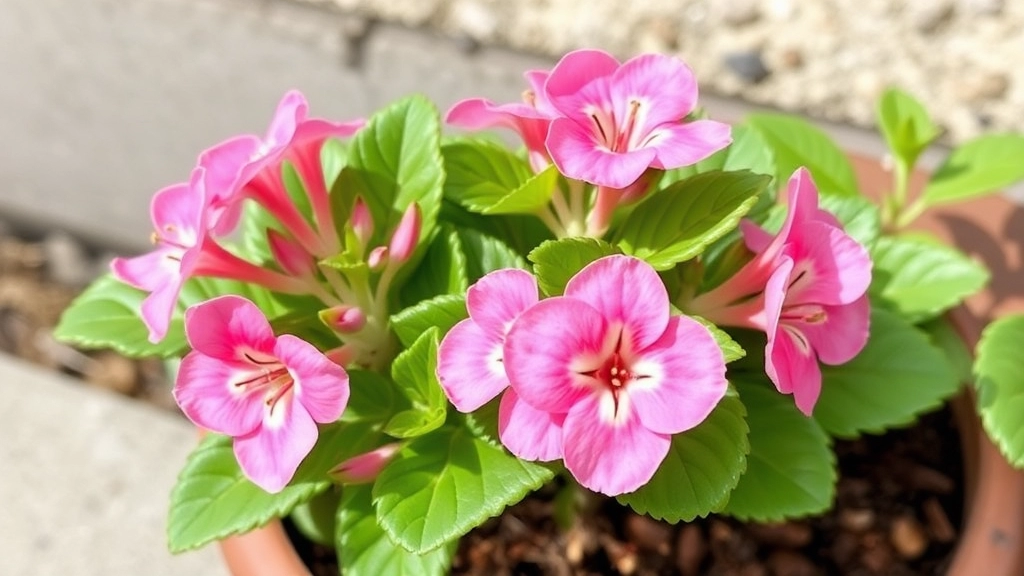Kalanchoe Pink Butterflies: A Unique Succulent
When it comes to unique succulents, Kalanchoe Pink Butterflies stand out with their vibrant pink plantlets. If you’re keen to add this eye-catching plant to your collection, understanding its care needs is essential. From ideal growing conditions to watering guidelines, we’ll cover everything you need to keep your Kalanchoe thriving.
Care Needs
Propagation is another exciting aspect of Kalanchoe Pink Butterflies. These plants are known for their ability to reproduce through plantlets, making them a favourite among succulent enthusiasts. Whether you’re a beginner or an experienced gardener, we’ll guide you through the best methods to propagate and maintain your plant’s health.
Ideal Growing Conditions for Kalanchoe Pink Butterflies
When considering the best environment for your Kalanchoe Pink Butterflies, you might wonder about the specific conditions that will help it thrive.
These stunning succulents flourish in warm, bright settings.
Temperature and Humidity
- Ideal Temperature: Kalanchoe Pink Butterflies prefer temperatures between 20°C to 25°C (68°F to 77°F) during the day.
- Night Temperature: At night, they can tolerate cooler temperatures down to 10°C (50°F).
- Humidity: They thrive in low to moderate humidity levels, making them perfect for indoor environments.
Light Requirements
- Bright, Indirect Light: Place your Kalanchoe where it can receive plenty of bright, indirect sunlight. Direct sunlight can scorch the leaves, while too little light can hinder blooming.
- Indoor vs. Outdoor: If indoors, a south or west-facing window is ideal. Outdoors, a spot with filtered sunlight works best.
Air Circulation
Good Airflow: Ensure there’s adequate airflow around the plant to prevent fungal issues and promote healthy growth.
For more detailed care instructions, check out our guide on how to care for Pink Butterflies Kalanchoe succulent. Additionally, if you’re interested in purchasing, we have the best deals on Kalanchoe Blossfeldiana available.
Watering Guidelines: How Much and How Often
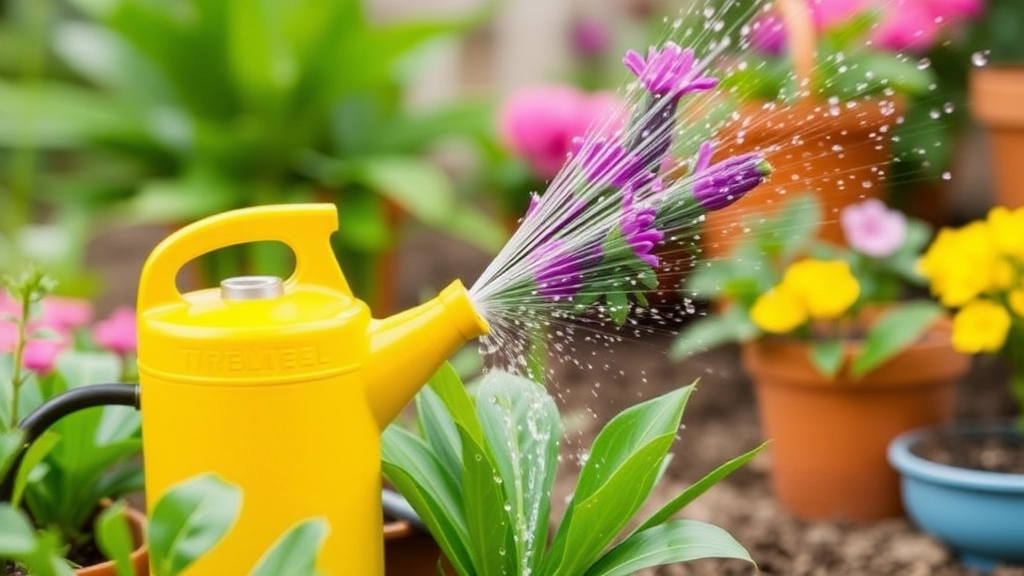
So, you’ve got your Kalanchoe Pink Butterflies, and now you’re probably wondering about watering.
Let’s be real—overwatering is a common pitfall for many plant parents.
How Much Water?
- General Rule: Water deeply but infrequently.
- Check the Soil: Stick your finger about an inch into the soil. If it feels dry, it’s time to water. If it’s still moist, hold off a bit longer.
- Watering Amount: Aim for enough water to soak through the drainage holes at the bottom of the pot, but don’t let it sit in a puddle.
How Often to Water?
- Growing Season (Spring & Summer): Every 2-3 weeks.
- Dormant Season (Fall & Winter): Once a month or even less, depending on humidity and temperature.
Tips for Success
- Use Room Temperature Water: Cold water can shock the roots.
- Avoid Watering Leaves: Focus on the soil to prevent rot.
I remember the first time I overwatered my Kalanchoe, and it was a lesson learned the hard way!
Best Soil for Optimal Drainage
When it comes to nurturing your Kalanchoe Pink Butterflies, the right soil is crucial for their success. Many plant enthusiasts often wonder, “What type of soil will keep my succulents thriving?”
For optimal drainage, consider the following soil characteristics:
- Well-Draining Mix: A standard potting soil can retain too much moisture. Instead, look for a soil mix specifically designed for succulents and cacti. These mixes typically contain sand, perlite, or pumice to promote drainage.
- pH Level: Aim for a slightly acidic to neutral pH (around 6.0 to 7.0). This range supports healthy root development and nutrient absorption.
- Homemade Mix Option: If you’re feeling adventurous, you can create your own blend. Combine:
- 2 parts potting soil
- 1 part perlite or coarse sand
- 1 part orchid bark or pumice
- Avoid Heavy Soils: Stay clear of heavy, clay-based soils. They can lead to water retention and increase the risk of root rot.
Using the right soil not only ensures adequate drainage but also provides the necessary nutrients for your Kalanchoe Pink Butterflies to flourish. For more detailed care tips, check out this guide on caring for Pink Butterflies Kalanchoe. Additionally, if you’re interested in learning about other Kalanchoe varieties, read our guide on Kalanchoe Tomentosa varieties.
Choosing the Right Pot for Succulents
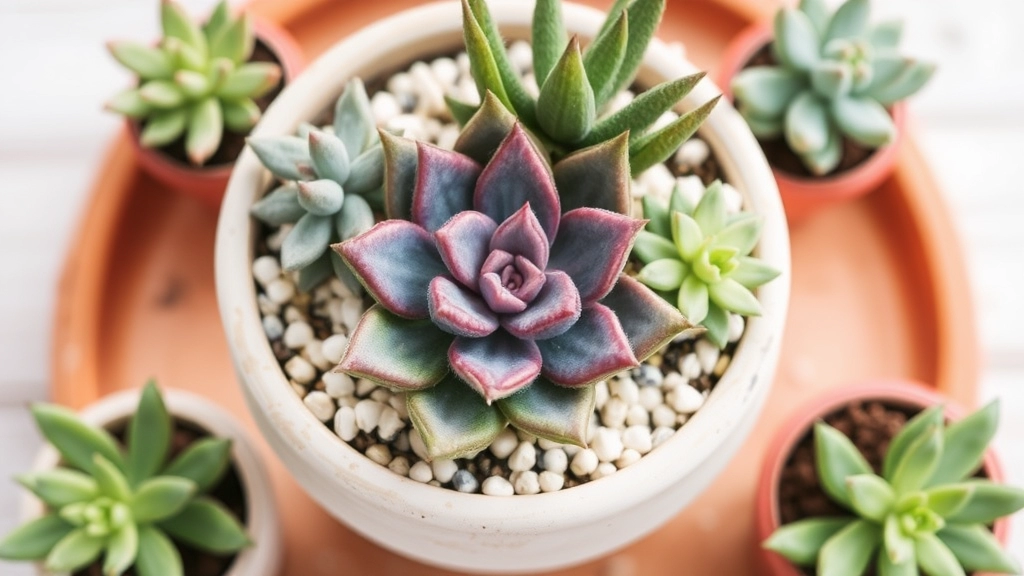
When it comes to nurturing your Kalanchoe Pink Butterflies, selecting the right pot is crucial for their health and growth. You might wonder, “What type of pot should I choose?” or “How does the pot affect my plant’s wellbeing?” Let’s explore these questions together.
Key Considerations for Pot Selection
- Material:
- Terracotta: Excellent for succulents due to its breathability, allowing for better airflow to the roots.
- Ceramic: Offers aesthetic appeal but ensure it has drainage holes.
- Plastic: Lightweight and retains moisture better, but choose pots with drainage.
- Size:
- A pot that is too large can hold excess moisture, leading to root rot.
- Aim for a pot that is just a couple of inches larger than the current root ball.
- Drainage:
- Always opt for pots with drainage holes. This prevents water from pooling at the bottom, which can be detrimental to your Kalanchoe.
- Shape:
- Shallow pots are often ideal for succulents as they promote healthy root growth without retaining too much moisture.
Additional Tips
- Consider Weight: If you plan to move your plants around, a lighter pot can be more manageable.
- Decorative Options: If aesthetics matter, you can place a plastic pot inside a decorative outer pot.
Choosing the right pot can make a significant difference in your plant’s growth and overall health. By focusing on material, size, drainage, and shape, you can create an ideal environment for your Kalanchoe Pink Butterflies.
Propagating Kalanchoe Pink Butterflies: Methods and Tips
Are you eager to expand your collection of Kalanchoe Pink Butterflies? Many plant lovers face the challenge of propagation, wondering about the best methods to use.
Propagation Methods
- Leaf Cuttings
- Select healthy leaves from the parent plant.
- Allow the cut ends to dry for a few hours to form a callous.
- Place the cuttings in well-draining soil, keeping them slightly moist.
- Roots should develop in a few weeks.
- Stem Cuttings
- Cut a healthy stem, ideally with a few leaves.
- Let the cut end dry for 1-2 days.
- Plant it in soil, ensuring it’s stable and upright.
- Water sparingly until roots form.
- Offsets
- Look for small plantlets that grow around the base of the parent plant.
- Gently separate them from the main plant.
- Replant them in their own pots with suitable soil.
Tips for Successful Propagation
- Timing: The best time to propagate is during the growing season (spring and summer).
- Humidity: Maintain a humid environment to encourage root growth.
- Patience: It may take several weeks for new growth to appear.
Propagating Kalanchoe Pink Butterflies can be a rewarding experience, allowing you to share these stunning plants with friends or expand your own garden. For more detailed guidance, you might find our step-by-step propagation guide for Kalanchoe Tomentosa helpful. Additionally, if you’re interested in exploring other Kalanchoe varieties, check out our Kalanchoe Succulent Identification Guide.
How to Identify and Treat Common Pests
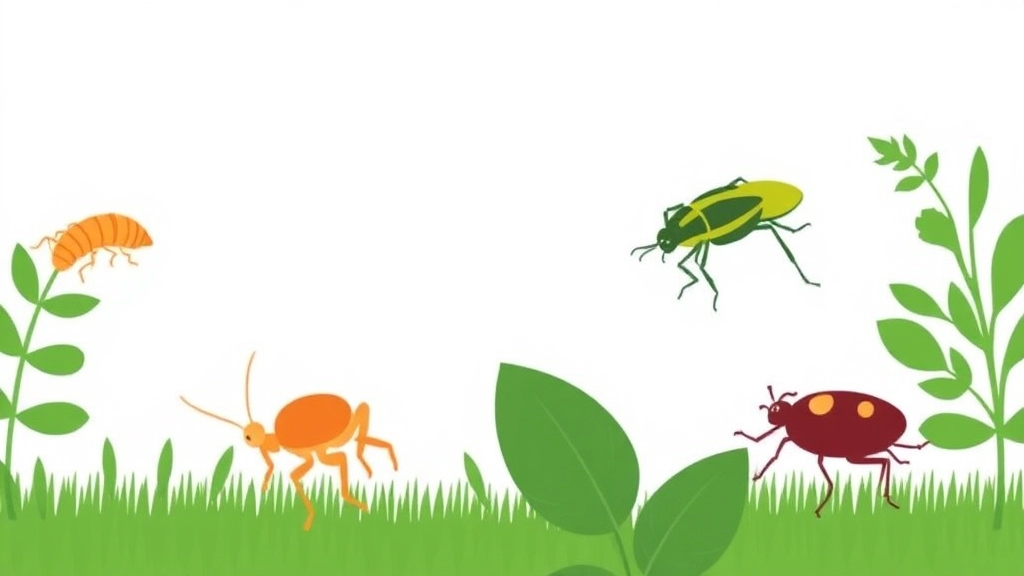
Ever looked at your Kalanchoe Pink Butterflies and thought, “What’s that weird spot?” You’re not alone. Pests can sneak up on us, and they love succulent plants just as much as we do.
Common Pests to Watch For
- Mealybugs: Little white cottony spots, often hiding in leaf joints.
- Aphids: Tiny green or black bugs that cluster on new growth.
- Spider Mites: Fine webs and tiny dots on leaves—check for them by shaking the plant gently.
- Scale: Hard, shell-like bumps on stems and leaves.
Identifying the Problem
- Visual Inspection: Regularly check the undersides of leaves and the stem.
- Sticky Residue: If you notice a sticky film, that’s honeydew from pests like aphids.
- Leaf Damage: Yellowing, wilting, or holes can indicate a pest problem.
Treatment Options
- Manual Removal:
- For mealybugs and scale, use a cotton swab dipped in rubbing alcohol.
- Wipe them off gently.
- Insecticidal Soap:
- Spray it on affected areas; it suffocates pests without harming your plant.
- Neem Oil:
- A natural pesticide that can deter many pests. Mix with water and spray.
- Diatomaceous Earth:
- Sprinkle around the base of the plant; it’s a natural barrier against crawling pests.
- Regular Monitoring:
- Keep an eye on your plant. Early detection means easier treatment!
Understanding the light requirements for your Kalanchoe Pink Butterflies is crucial for maintaining their health and vibrancy. For indoor placement, it’s best to provide bright, indirect sunlight. Avoid direct sunlight as it can scorch the leaves, leading to unsightly brown patches. South or west-facing windows are ideal spots, offering ample light without the harshness of the midday sun. For more detailed care tips, you can refer to our [guide on how to care for Pink Butterflies Kalanchoe succulent](https://planthq.org/how-to-care-for-pink-butterflies-kalanchoe-succulent/).
When placing your Kalanchoe outdoors, they prefer partial shade, especially during the hottest parts of the day. A few hours of morning sun can be beneficial, promoting healthy growth and vibrant colors. Ensure they are shielded from strong winds and heavy rain, which can damage delicate leaves. For more insights on outdoor care, check out our [complete guide to growing and caring for succulent plant Kalanchoe](https://planthq.org/ultimate-guide-to-growing-and-caring-for-succulent-plant-kalanchoe/).
Seasonal Care: Adjusting Water and Fertilizer Needs
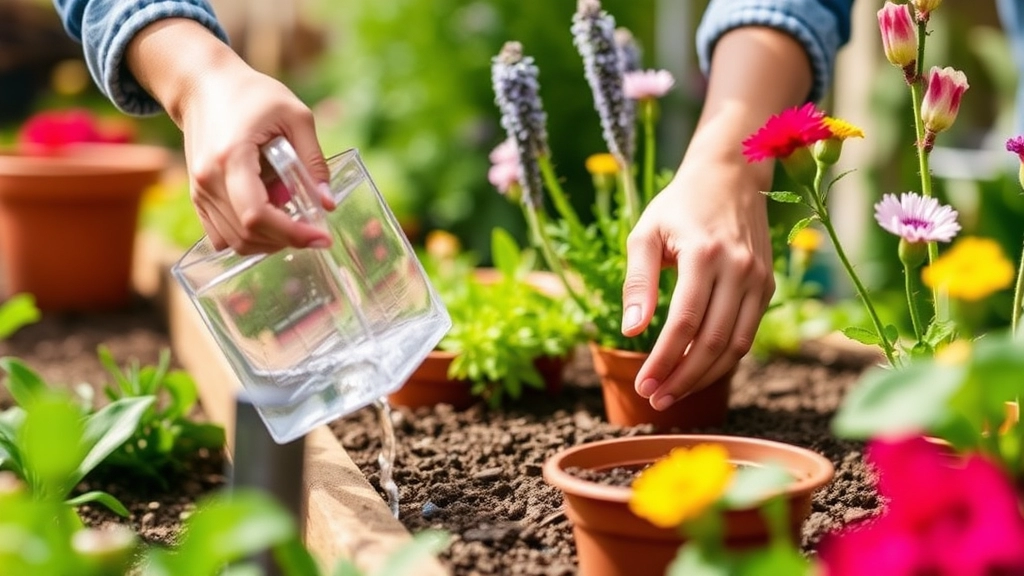
So, you’ve got your Kalanchoe Pink Butterflies thriving, but how do you keep them looking fabulous all year round? Seasonal care is key, especially when it comes to water and fertilizer.
Watering Needs by Season
- Spring & Summer: These are the growing months. Your Kalanchoe will need more water as it actively grows.
- Water every 1-2 weeks, allowing the soil to dry out completely between waterings.
- Autumn & Winter: The plant goes into dormancy.
- Cut back on watering to every 3-4 weeks.
- Make sure the potting mix is almost dry before you water again.
Fertilizer Guidelines
- Spring: Time to feed! Use a balanced, water-soluble fertilizer.
- Apply every 4-6 weeks to encourage lush growth and vibrant blooms.
- Summer: Keep feeding but be cautious.
- If your plant looks healthy, you might skip a month.
- Autumn & Winter: Hold off on fertilizing.
- The plant’s energy is focused on resting, not growing.
Quick Tips to Remember
- Always check the soil moisture before watering.
- Use a diluted fertilizer to avoid overloading your plant with nutrients.
- Adjust your care based on your local climate; hotter or colder areas may need different approaches.
Repotting Tips for Healthy Growth
Have you ever wondered when the right time is to repot your Kalanchoe Pink Butterflies?
Repotting is crucial for maintaining healthy growth and ensuring your plant thrives.
When to Repot
- Signs of Root Bound: If you notice roots growing out of the drainage holes or the plant seems to be stunted, it’s time to repot.
- Frequency: Generally, repotting every 1-2 years is ideal.
Choosing the Right Time
Spring or Early Summer: This is the best time to repot, as the plant is actively growing.
Preventing Root Rot and Overwatering Issues

Have you ever looked at your Kalanchoe Pink Butterflies and thought, “Why are my leaves turning mushy?” If you’re nodding along, you’re likely dealing with root rot or the dreaded overwatering.
Understanding Root Rot
Root rot is a sneaky villain in the world of plant parenting. It creeps in when your plant sits in soggy soil for too long. Here’s how to keep that pesky issue at bay:
- Check the Soil: Always opt for well-draining soil. A mix designed for succulents or cacti works wonders.
- Water Sparingly: Allow the top inch of soil to dry out before watering again. Trust me, your plant will thank you.
- Pot with Drainage Holes: Make sure your pot has holes at the bottom. This allows excess water to escape, preventing that soggy situation.
Signs of Overwatering
If your plant’s leaves are looking plump and translucent, it might be too late. Here’s what to keep an eye on:
- Mushy Leaves: A clear sign that your plant is drowning.
- Yellowing Leaves: If the leaves are turning yellow, that’s a cry for help.
- Foul Smell: A rotten smell coming from the soil? That’s a red flag.
Quick Tips to Avoid Overwatering
- Stick to a Schedule: Water every 2-3 weeks, adjusting based on humidity and temperature.
- Use a Moisture Meter: These handy tools can help you gauge when it’s time to water.
- Elevate Your Pot: Use pot feet or a small tray to keep the pot off the ground. This promotes airflow.
Managing Temperature and Frost Protection
As we transition from understanding the watering and soil needs of Kalanchoe Pink Butterflies, it’s essential to consider how temperature and frost can impact their health.
Ideal Temperature Range
Kalanchoe Pink Butterflies thrive in warm environments, ideally between 20°C to 25°C (68°F to 77°F).
- Avoid Cold Drafts: Sudden temperature changes can stress the plant.
- Indoor Placement: Keep them away from unsealed windows and doors during winter.
- Outdoor Care: If placed outside, ensure they are in a sheltered spot during cooler months.
Frost Protection
Frost can be detrimental to Kalanchoe Pink Butterflies, leading to wilting and even death. Here are some proactive steps to protect them:
- Bring Indoors: If temperatures drop below 10°C (50°F), bring your plants inside.
- Use Cloches or Covers: For outdoor plants, consider using frost cloths or cloches during chilly nights.
- Mulching: Apply a layer of mulch around the base if planted in the ground, which can help retain heat.
Monitoring Temperature
Keeping an eye on temperature fluctuations is crucial.
Maximizing Color and Plantlet Growth in Kalanchoe Pink Butterflies
So, you’ve got your Kalanchoe Pink Butterflies thriving, but how do you really make those colours pop and encourage plantlet growth? It’s a common worry for many plant lovers, and I’m here to help you get the most out of your gorgeous succulents.
Light Exposure is Key
First things first, light is your best friend.
- Bright Indirect Light: These beauties love bright, indirect sunlight. Too much direct sun can scorch those delicate leaves.
- Rotate Your Plant: Every few weeks, give it a gentle twist to ensure even light exposure. This helps create a balanced, bushy plant.
Fertilizing for Vibrancy
Next up, let’s talk fertilization.
- Use a Balanced Fertilizer: During the growing season, a balanced liquid fertilizer diluted to half strength can work wonders.
- Frequency: Feed your Kalanchoe every 4-6 weeks. This boosts growth and enhances those stunning colours.
Pruning for Growth
Don’t forget about pruning!
- Remove Dead Leaves: Snip off any dead or yellowing leaves. This not only keeps your plant looking fresh but encourages new growth.
- Encourage Branching: If your plant gets leggy, trim back some of the longer stems. This promotes bushier growth and more blooms.
Watering Wisely
Watering is crucial for both colour and growth.
- Check the Soil: Always let the top inch of soil dry out before watering again. Overwatering can lead to dull colours and stunted growth.
- Water at the Base: When you do water, aim for the base of the plant. This helps avoid soggy leaves.
Temperature Matters
Lastly, temperature plays a role in how vibrant your Kalanchoe can be.
FAQs for Kalanchoe Pink Butterflies
How often should I water my Kalanchoe Pink Butterflies?
During the growing season (spring and summer), water your Kalanchoe every 2-3 weeks. In the dormant season (fall and winter), water once a month or less, depending on humidity and temperature.
What type of pot is best for Kalanchoe Pink Butterflies?
Terracotta pots are excellent due to their breathability. Ceramic pots are also good if they have drainage holes. Plastic pots retain moisture better but ensure they have proper drainage.
How can I prevent overwatering and root rot?
Use well-draining soil and a pot with drainage holes. Allow the top inch of soil to dry out before watering again. Avoid letting the pot sit in water.
What are the signs of overwatering my Kalanchoe Pink Butterflies?
Signs include mushy leaves, yellowing leaves, and a foul smell coming from the soil. These are indicators that your plant is receiving too much water.
What common pests should I watch out for?
Common pests include mealybugs, aphids, spider mites, and scale. Regularly inspect your plant for these pests and treat them promptly.
How do I treat common pests on my Kalanchoe Pink Butterflies?
Manual removal using a cotton swab dipped in rubbing alcohol can help with mealybugs and scale. Insecticidal soap and neem oil are also effective treatments. For crawling pests, sprinkle diatomaceous earth around the base of the plant.
How should I adjust watering and fertilizing by season?
In spring and summer, water every 1-2 weeks and apply a balanced, water-soluble fertilizer every 4-6 weeks. In autumn and winter, reduce watering to every 3-4 weeks and hold off on fertilizing.
What should I consider when choosing a pot for my Kalanchoe Pink Butterflies?
Consider the material (terracotta, ceramic, plastic), size (just a couple of inches larger than the root ball), drainage (always opt for pots with drainage holes), and shape (shallow pots are often ideal).
How can I identify if my Kalanchoe Pink Butterflies has pests?
Look for visual signs such as white cottony spots, tiny green or black bugs, fine webs, and hard, shell-like bumps. Sticky residue and leaf damage are also indicators of pest problems.
What are the best practices for seasonal care of Kalanchoe Pink Butterflies?
Always check soil moisture before watering, use a diluted fertilizer, and adjust care based on your local climate. During growing months, water more frequently and feed the plant; during dormancy, reduce both.
References
-
How to Water Succulents: The Essential Guide
-
Choosing the Right Pot for Succulents
-
Pest Identification Guide
